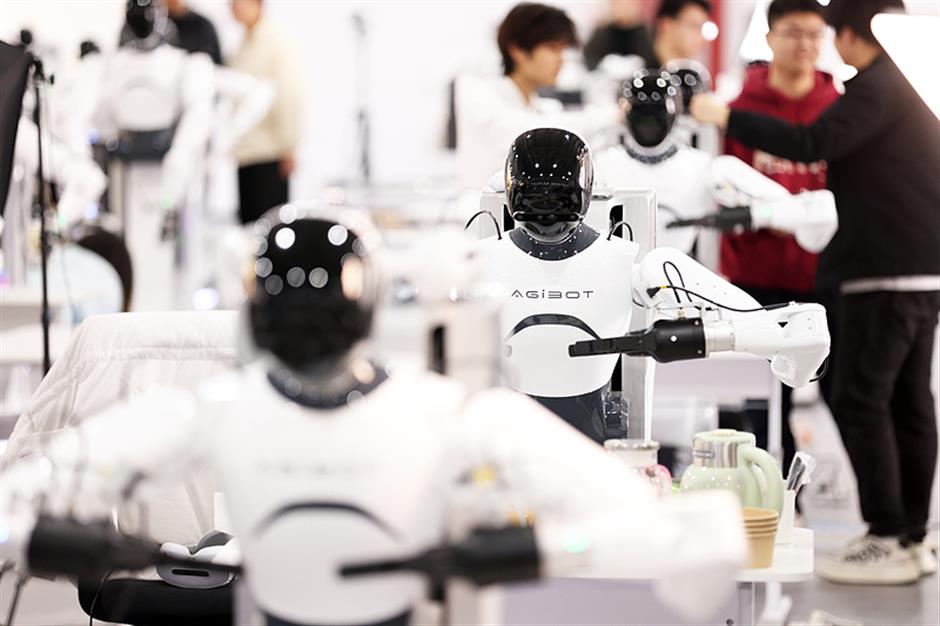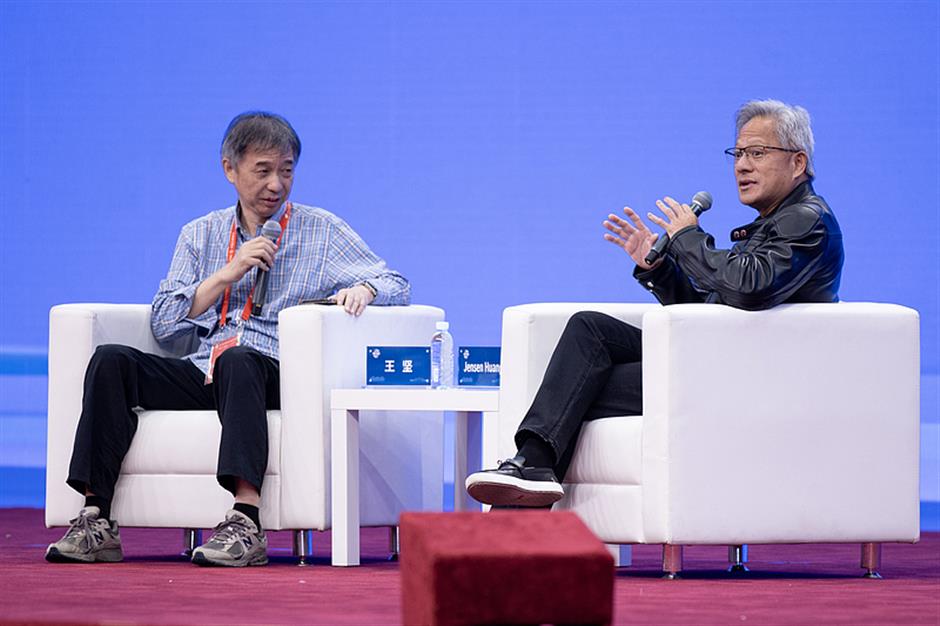
China's high-end manufacturing isn't just building components; it's building clout.
At the recent China International Supply Chain Expo in Beijing, more than 650 companies and institutions from 75 countries and regions gathered to explore the less glamorous but more powerful B-side of the "supply chain" – integration. Not just production, but coordination. Not just factories, but ecosystems.
Half of the participating foreign companies at expo were from Europe and the US, and about two-thirds were Fortune 500 luminaries or other ranking industry leaders.
Translation: The world is starting to see "made in China" as more than a low-cost slogan but as an anchor in the value chain.
Chip giant Nvidia, for the first time, had a booth at the exhibition. Chief Executive Jensen Huang praised Chinese developers of "large language models" as world-class, singling out Deepseek, Alibaba and Tencent. Nvidia also unveiled a graphics processing unit tailored to comply with US restrictions on chips exports to China.
Mohamed Kanda, global chairman of multinational professional services firm PwC, called the expo "a forest of connections" that links Chinese innovation with global manufacturing ambitions.
But here's the puzzle. If China is so successful in climbing the technology ladder, why isn't it dominating global markets?

Training inside Shanghai-based Agibot
A US-China Business Council survey this year tells a cautionary tale: The percentage of profitable US companies doing business in China has dropped to 82 percent from 97 percent in 2019. Nearly a third of them are losing market share, squeezed by tariffs and rising costs.
Hence, the big question: How can China turn its manufacturing muscle into global market power? What's blocking the path beyond the factory gates?
The answer may lie not in machine but in margins – the margins of soft power. In today's world, the real edge lies in controlling upstream resources, deploying financial instruments and shaping the cultural narrative. These forces can move revenue more than any single tariff or tech upgrade.
So China's role in the global supply chain is shifting from making and selling to orchestrating and owning the narrative. From mine to market, China wants to participate into the global value chain end to end.
Controlling manufacturing input
Tech and capacity mean little without raw materials. In high-end manufacturing, precision output demands precision input, such as semiconductor-grade quartz, battery-grade lithium, aerospace alloys. Who controls the feedstock controls the factory.
Chinese firms face a double bind. First, Western commodity giants like Glencore, Cargill, Vitol and Trafigura dominate extraction, storage, shipping and derivatives. As the book "The World for Sale" shows, they shield themselves from volatility while exporting price risk to buyers like China. At the same time, rising resource nationalism in developing countries cuts both ways. Indonesia tightens nickel exports. Brazil tightens iron-ore licenses. The Democratic Republic of Congo insists on local cobalt processing. Niger reclaims control of uranium and oil.
Chinese producers now find themselves boxed in by sovereignty-driven barriers and surging costs.
So how does Beijing break free? On the national front, it has stepped up domestic exploration.
Last year alone, PetroChina announced major oil and gas finds in the western Tarim Basin. Geologists have uncovered new rare-earth deposits in Inner Mongolia and lithium reserves in Sichuan. China's self-reliance ratio on critical minerals is climbing. When overseas threats to China's imports loomed in tensions with the US, Beijing rolled out new licensing rules for rare-earth exports critically needed in industrial production.
At the industry level, diversification and coordination are underway. An alliance of battery giant CATL and Huayou Cobalt in Zimbabwe's lithium belt shows the power of unity. China's CMOC and Zijin Mining are pursuing similar integration. Oil majors like Sinopec and Cnooc aren't just pumping barrels; they're trading futures and options in Singapore to hedge risk and influence benchmark prices. Tsingshan, formerly a stainless-steel processor, now owns nickel mines and smelters in Indonesia and the Philippines.
Processing remains China's strong card. It may not mine ore, but it refines it. Over 60 percent of rare earths, 68 percent of lithium compounds and 80 percent of cobalt refining happen on Chinese soil.
In effect, China can turn its input disadvantage into a geopolitical lever. It doesn't need to own a mine; it just needs to control critical junctures beyond the mine mouth. Through mineral diplomacy in Central Asia and port deals in West Africa, Beijing is building an infrastructure that redefines who profits from the world's raw material flows. The battle for manufacturing supremacy starts underground and ends in commodity trading pits.
Building financial bridgeheads
Exchange rates and borrowing costs bite harder than headline tariffs. The overseas borrowing rate for Chinese companies is usually above 10 percent, compared with the US federal funds rate of between 4.25-4.5 percent. The rate acts like an invisible levy on every yuan-denominated export or overseas investment.
So which hurts more – a fleeting tariff bump or the ongoing burden of high interest rates and forex volatility?
China's banks still trail global peers overseas. The Big 5 state-owned banks – ICBC, Bank of China, China Construction Bank, Agricultural Bank of China and Bank of Communications – together operate fewer than 1,500 branches and representative offices abroad. Contrast that with UK-based HSBC, which alone has thousands of overseas outlets.
China hopes to narrow that gap by turning the yuan into a more international currency. In March, the yuan became the world's fourth-most active currency used on the Brussels-based SWIFT network of international payments. That helps increase offshore liquidity.
Meanwhile, Project mBridge, a multiple central bank digital currency platform based on blockchain, now links China, Thailand, the United Arab Emirates and Saudi Arabia, chipping away at dependence on the US dollar as the dominate global trade currency.
Financial technology is the wildcard. Singapore-based Airwallex's latest US$300 million Series F funding round valued the company at US$6.2 billion. Stablecoins, multi-currency wallets and blockchain trade-finance platforms let exporters execute foreign-exchange trade faster, hedge risks and track supply-chain flows.

Nvidia's Jensen Huang (right) and Alibaba Cloud founder Wang Jian discuss AI at the recent China International Supply Chain Expo in Beijing.
Crafting cultural capital
How do you turn "made in China" from a budget tag into a cultural badge? In the everyday life of food, fashion and household goods, consumers climb the price ladder on value and style. European and American brands like LVMH and Apple, and Japanese and Korean icons such as Sony and LG, snatch their attention by anchoring their products to lifestyle stories.
The narrative matters. China, for example, exported 400,000 tons of tea last year in 2024, but a 22 percent price drop kept producers stuck at the commodity end. Why pay more for a Chinese label when Lipton, Twinings and other mass-market brands own the marketing narrative?
Tech companies are changing the script. Shenzhen-based DJI claims roughly 70 percent of the global drone market after pairing hardware excellence with a content ecosystem that turns pilots into storytellers. Insta360 built a fan base around its 360-degree cameras with a user-generated film gallery. The role-playing game Genshin Impact embraced immersive storytelling, turning a free-to-play model into a US$710 million cultural phenomenon in 2024. These brands don't just sell gadgets, they sell experiences and emotion.
Trendy brands are becoming cultural ambassadors. Pop Mart's Labubu doll collectibles generated US$423 million in sales, turning toys into fashion must-haves. Artificial general intelligence platforms like Kuaizi are localizing narratives in dozens of languages, letting Chinese products speak directly to regional tastes. "Made in China" is stepping onto the global cultural stage, one story at a time.
When global demand peaks and old narratives shows cracks, the rules of the supply-chain game change. Efficiency and technology no longer suffice. Tomorrow's value will hinge on emerging aesthetics and cultural resonance. The winners will those best able to demonstrate that what you stand for matters as much as what you sell.
China is positioning itself as lead architect of a new global supply-chain ethos that prizes interconnection over isolation, trust over domination and shared benefits over zero-sum gain. It is building South-South dialogue platforms, widening financial access beyond entrenched gatekeepers and embracing green standards and culturally relevant brand ecosystems.
(The author is founder of WisePromise, a boutique advisory agency specializing in the international expansion of Chinese tech companies in the advanced hardware and energy sectors. He also serves as a geo-economic expert for several think tanks in Beijing.)

